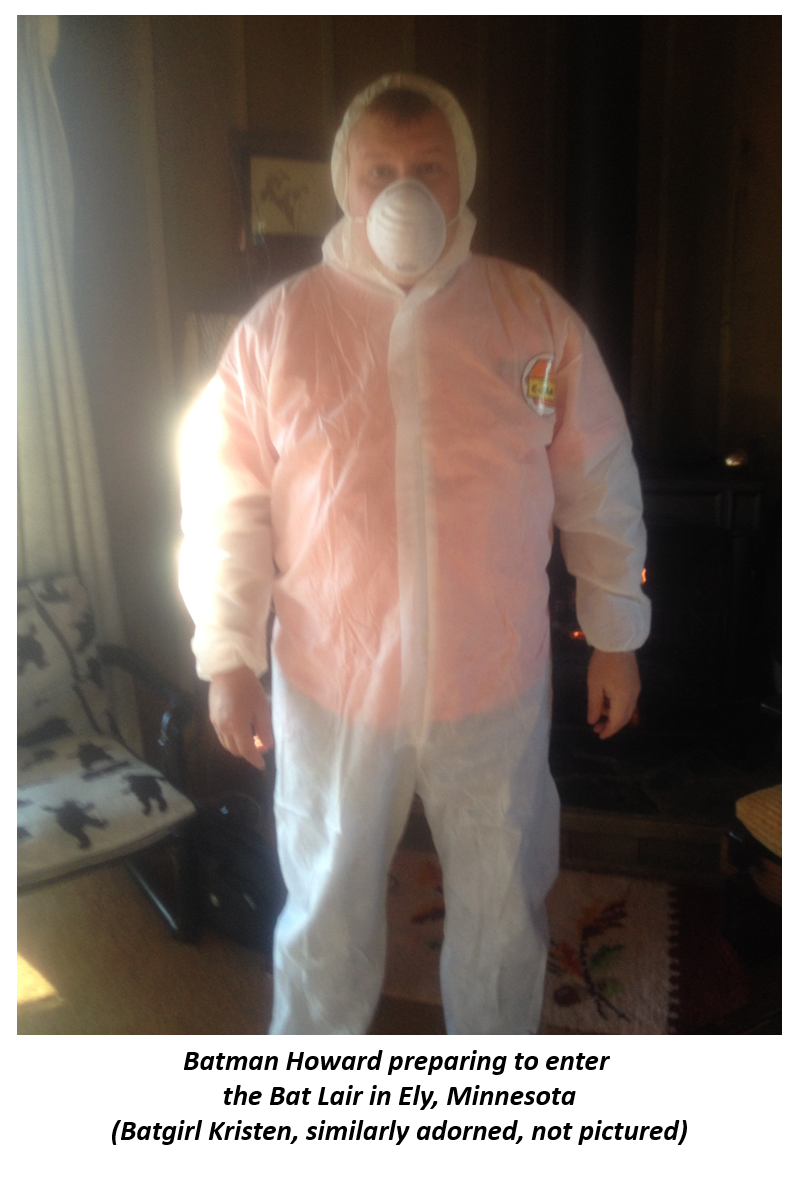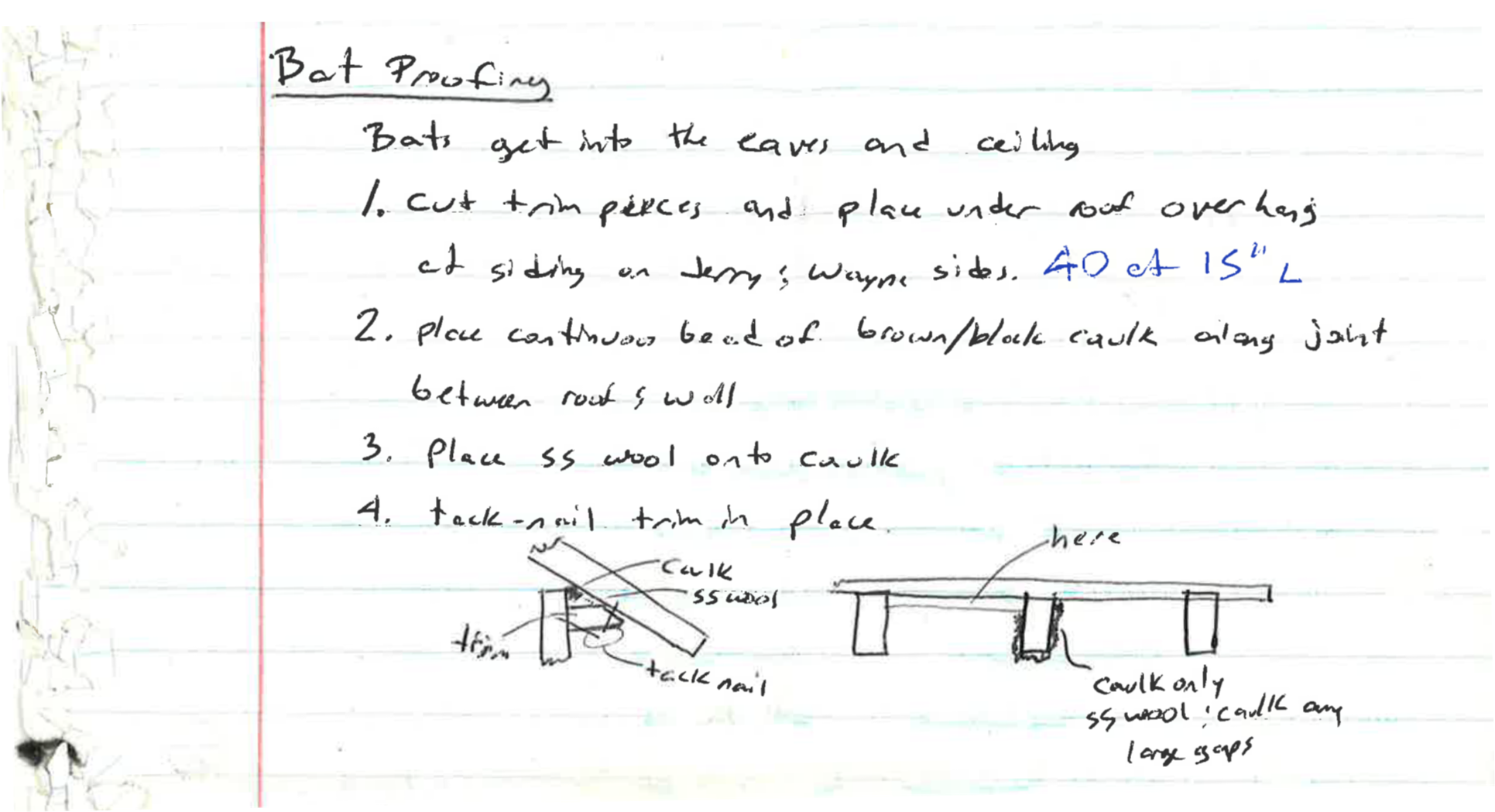


An Engineer in the Woods, Installment 5: Critters #3, Batman and Batgirl Succeed!
Friday, September 29, 2017

I grew-up being mesmerized by bats. During the warm summer days while on vacation in Minnesota I would collect crickets, and grasshoppers and beetles and sometimes even resort to worm bits. At dusk, I would go to the dock and toss the offerings one at a time into the dark sky and watch in amazement as bats would swarm around me, find the snacks with echo-location and snatch them out of the air. Many evenings, when there was a feeding frenzy, you could occasionally add a small rock or stick to the mix – they would only be momentarily snatched before making soft plinks into the water when the hungry critters realized they had been duped. Eventually, the mosquitoes would begin to get thick, and the bats would begin diving toward your head to get them. That is when fascination turned to horror, and it was time to go back inside.
When I was 11 or 12 and we started staying in the uncompleted cabin (another Hamilton project!), bats would occasionally find their way into the house, and they joined the list of “woodland critters” that were understood to just be “part of the deal” with having a cabin in the woods. They were quickly moved-out, or moved-on to a higher plane if necessary. But it was not a problem – they were expected every once in a while.
But at some imperceptible point a few decades later the occasional incursion became an infestation.
Mom and Dad would spend weeks at a time at the cabin, and their bedroom was downstairs. The adult kids (including Kristen and me at this point), and their (including our) kids, stayed in the upstairs bedrooms. When you first went upstairs after the cabin had been closed for a while, and especially on hot days, there was a strong odor which we would blame on dead mice, mildewy camping gear that was stored under the eaves, or simply closed-up cabin smell. It didn't bother Mom and Dad, because they stayed downstairs, but for us second floor dwellers it could be pretty gross. If we were up in the Spring(our most common time due to the combination of band and sports schedules), each night there would be constant activity in the A-Frame ceiling above our heads as bat families moved-in and out of the cabin in an endless parade of scratching, scrambling, and screeching. The Spring after I had met Buford the Joliet Batguy (see Installment #4) there was one night when Kristen and I could barely sleep due to the endless bat party! Something had to be done!
At the first light of dawn I carefully walked around the cabin looking for piles of bat crap (“guano” per Buford). The regular crap scatterings that were always on the deck suddenly spoke to me. Bats weren’t just getting into the roof and eaves in a few places, they were getting in where the roof meets the walls for the entire lengths of two sides of the cabin. Once the bats squeezed through that small continuous crack between the siding and the roof decking they were in the eaves and had access to the backside of the sloped ceiling over the bedrooms for their nightly parties. We were vacationing in a bat-crapdominium.
I couldn’t fix it now because I remembered the “Night of the Bats” that occurred when I was about 13. Earlier on the morning before “The Night” (as it came to be called), Dad had found a hole around a plumbing vent in the eaves, and decided that that was where bats were getting-in – so he plugged it that afternoon forgetting what Marlin Perkins had taught us during Sunday night TV on Wild Kingdom. “Bats sleep during the day and forage at night.” The foraging must have begun at 8:35 that night when the bats found that they couldn’t get back outside, because that is when the first bat flew down the circular staircase and into my sister Helen’s hair as we sat at the table playing Monopoly. Then we found one behind the bathroom door. Our 22-pound terrier mutt, Candy, dropped a dead one at Dad’s feet (her sister Pretty just looked confused as she often did). Damn the mosquitoes, we got a couple of the bats to fly out of open doors, though the ratio of mosquitoes-in to bats-out was about 2,093 : 1.
That night we slept fitfully with our heads under the covers due to both the bats and the mosquitoes!
The next morning, I found two more bats and a very important lesson was ingrained into my brain for the rest of my life, “Do not plug bat holes during the day
All that I could do now, during the day, was take measurements, develop a design, and start planning. I had learned years ago that mice can’t chew through steel wool. However, steel wool rusts, so I had used stainless steel wool and caulk to fill cracks at Mom’s house in an effort to reduce the mouse infestation. I assumed that bats are not any better chewers than mice.
I also knew from researching, designing and building bat houses at our home in Plainfield that bats like to wedge themselves into about 45o spaces. The pitch of the roof at our cabin is 12:12 (45o) – a perfect bat haven, further evidenced by the ever-present bats hanging on the sides of the house. I had to make our cottage less bat hospitable.
If I filled the suspected bat-crack with caulk and stainless steel wool, the bats could not chew their way in, but they might be able to pull the material out. If I put a piece of cedar trim between the roof and siding the 45o bat-wedge home would be gone, and the bats wouldn’t like to hang there anymore. If an industrious bat wanted to chew through the cedar trim, the steel wool would stop it from getting into the house. The trim would also keep the caulk from being pulled-out. The design seemed solid (see sketch below), but when could I build it?

That night as I lay in bed sleepless, I listened intently to hear when the bats were and weren’t moving around. As near as I could tell, there was always some activity. If they were ALWAYS inside, I could never plug the cracks to keep the bats outside! <crap!>
About 3:00 am our aging calico, Lizzy, jumped onto my chest, left a damp present on my left shoulder and began to purr proudly– <Oh what fresh Hell is this?!>
I pulled a tissue from the box on the night stand, and enveloped the moist morsel into the palm of my right hand. It seemed smaller than either a mouse or a bat. I just hoped it was dead so that it wouldn’t bite me, and that it was not too bloody thus leaving a stain on the sheet. I pushed the cat off and rolled out of bed. Kristen startled, “What?”
“Bathroom.” It wasn’t a lie, that is where I was headed, with <God only knows what> rolled into my hand….
I stepped into the dark upstairs bathroom, lit only by a nightlight. I pushed the door closed so as to not wake anyone, and flipped-on the vanity light so that I could see. I dropped the wadded tissue into the sink. The critter was dead, but no blood, and I could see tiny black clawed feet sticking-out of one end of the wad and a pointy black nose with sharp white needle sized teeth at the other end. I had never seen one like this before, but I was pretty sure I knew what it was…I peeled back the damp tissue and confirmed my suspicion – A BAT! Not your normal Little Brown, or occasional but much larger Common Brown. This one was tiny and jet black. Only about 2½ inches from pointy nose to tiny feet, it was so black as to be shiny. I stretched-out the wings of the lifeless critter and they were scalloped like the Batman logo:

I had never seen a bat like this before, but this is what a bat is supposed to look like – not the dusty brown snub-nosed critters I was used to in Minnesota (and now at Mom’s house). It also explained why we now have so many. If a Little Brown can squeeze through a crack the thickness of a nickel, something this tiny and greasy could squeeze into anything – we could have hundreds in the ceilings! I shuddered.
But then I started to fret…is it an endangered bat? We had been involved in construction projects that had been stopped by bats – Indiana and Long-Eared. Could this be a “rare” bat like them? Would we have to move out of the cottage during bat breeding season? Would we have to seal off the upstairs and live with bat-stench forever? I needed to do some research. I memorized the details of the critter and disposed of it with a quick splash and flush. I grabbed a disinfecting towelette and in the dark bedroom I tried to wipe the mostly cat spit smudge out of the bed sheet without waking Kristen. Once I was convinced that the germs, if not the stain, had been eliminated, I folded the sheet over to Kristen’s side (I hope she doesn’t read this) and got into bed to try to grab a little shut-eye. I was unsuccessful, so I just lay there listening to the bats and thinking until the noisy pre-dawn birds, combined with the incessant bat scrambling, made any attempt at sleep futile.
When we had a “town day” later that week, a 20-minute drive, I went to the internet café and researched Minnesota bat types on my iPhone. The black bats were Silver Haired and not rare. I also learned that they were probably raising their brood in the ceiling so that even if I was able to plug the crack while the adults were out, they would try desperately to get back in for their offspring until the babies died and rotted in the ceiling after days of squealing – not a pleasant thought. A quick Google for “Do Minnesota bats migrate,” or “hibernate,” for both Little Browns and Silver Haired returned many conflicting answers about “when,” “where,” and “if.” So, I hatched a plan.
- Kristen and I would return the last week of October, which should be well after a hard frost, on the theory that freezing air = no bugs = no bats. Any snow on the ground could probably be measured in inches (not feet), so we should be able to get in and out of our 1.1 mile-long lane. If we waited until November we would be risking frozen water pipes and the need for snowmobiles!
- I would suit-up with a particulate mask, full body covering, booties and gloves.
- I would check under the eaves to see if there were any hibernating bats. If there were none, I would proceed to Step 4. If they were present I was considering multiple “options” better left unwritten…
- We would install our bat proofing caulk, steel wool and cedar trim in a two-step process:
- Kristen, on one ladder, would push stainless-steel wool into the crack between the outside walls and the roof decking.
- I, on another ladder, would place a bead of caulk over the steel wool and nail pre-cut, pre-painted trim pieces into place using a nail gun
- Everything under the eaves would be taken to the dump. We hadn’t looked at most of it for over 40 years, so it wouldn’t be missed.
- I would donate my ShopVac and vacuum any dead mice, dead bats, crap, guano, bugs… and either throw the ShopVac away, or disinfect it and leave it under the house for future icky uses. It was NOT going back home in our van!
- I would wash the floor of the eaves with water and bleach, and let things dry overnight.
- The next day I would use a spray gun to paint EVERYTHING under the eaves with Kilz mildew resistant primer.
- We would sleep downstairs to limit exposure to chlorine and paint fumes.
With good weather, we could do this in 3 days, but we scheduled a week just in case.
Did I just prove that engineers over-plan and over-analyze??
When Kristen and I returned on October 24, 2014 we had beautiful sunny weather, no snow, no living bats, and the plan was executed flawlessly. Three years later, and after a subsequent caulk and steel wool mouse-proofing of the plumbing penetrations under the house with the use of slave labor provided by our 3 adult children, one boyfriend and one nephew, we can now certify the cabin to be mouse and bat-free for the first time in 45 years!
The cabin now smells like the northwoods, not critters!

Have a beautiful, odorless day!
Howard